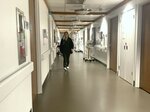

A few columns ago, I wrote about my son’s partner’s experience in Overlake Hospital’s Emergency Dept (ED) in Bellevue. I felt the care given to her was exceptional in the few short hours I spent with her on 3 West, their new post-ED Short Stay Unit. This was in sharp contrast to how things went for my son in Olympia at Providence St. Peter’s ED a few months earlier.
Ryan Hodges, Senior Public Relations Specialist at Overlake set up a TEAMS meeting for me with 4 of Overlake’s leadership team. One hour with them was enough to get a glimpse of what is special and how they accomplish what they do.
Creating a CULTURE OF CARING takes COMMUNITY, COLLABORATION, COOPERATION, and COMMITMENT to take the Patient (and Community)-Centered Care Promise seriously.
Tamara Kam, Overlake’s Director of Patient Experience, leads their PFAC. This is a group of staff, physicians, and a diverse group of community members. Each member is required to serve a term of 3 years with the option for two more. To date, everyone has served the full five years because they love making a difference!
The administration not only supports the council’s work; they expect their support. “From the top down, they want our help, and they walk their talk,” says Kam. After leaving our meeting early, the others piped in to say that Tamara is one of a kind, having produced outstanding results leading this council in her four short years at Overlake.
Alice Cloutier, RN Nurse Manager of the Emergency Department and 3 West Short Stay Unit, rushed to our meeting from the ED where she had been helping in the unit (which means the manager was ‘getting her hands dirty’ helping with patient care). It was a Black Surge Day, which means = VERY BUSY!
1 - Every single patient survey is read by unit leaders and administrators to the tune of thousands each year.
2 - Alice adds, “We take all the feedback seriously. We share it with staff, the good and the bad. We let people know if they were appreciated. We make suggestions actionable when we can. We praise what we want more of.”
3 - Here are a few patient requests they were able to accommodate:
>One patient asked for a recliner to rest in the waiting room. Staff and admin looked into it and voila: there are now seven recliners in the ED waiting room!
>An African American patient requested a special shampoo and voila: that shampoo choice is now available! A request of this type is not considered trivial in an organization that takes patient-centered care seriously.
Manager Alice’s words, “This is how change starts with compassionate care.”
Lisa Morten, Chief People Officer, enlightened me further on how Overlake creates a culture of caring.
Overlake practices JUST CULTURE, a methodology for reducing risk and improving safety. Leadership refrains from blaming and shaming and instead maintains an attitude of helping staff succeed. Their job is not to reprimand but to help staff solve challenges, improve quality, and avoid mistakes.
Every department has a SHARED LEADERSHIP COMMITTEE comprised of any employee who wishes to participate. This includes physicians, housekeepers, aides, nurses, and more, depending on the department. Together, they help lead the department in contrast to the manager and her superiors.
Leaders they hire are expected to be transparent and cooperative, to be open to employees helping to guide decisions and processes.
The ED committee wanted to do something about their 6-7 hour wait times and 4.6% risk of a patient “Leaving without Being Seen (LWBS).” These LWBS patients are known to be at very high risk of having bad outcomes. So, in the last year, they came up with a process they call Vertical Triage. In this new process, patients are seen by a physician or provider quickly, followed by treatment and diagnostic test initiation. Afterward, patients return to wait in the ‘vertical area’ for results and further plans. Since instituting this process change, wait times have substantially shortened and the LWBS rate has decreased to 0.9%!
Have they had the kind of staff shortages we have in Olympia? How are they dealing with the state and nationwide healthcare personnel shortage? Ms. Morten said that Overlake has not been immune to staff shortages, but the last two years have been record hiring years!
Why do people choose to work there? A number of the employees I talked to on my visit chose to commute to work at Overlake. To what does she attribute their hiring and employee retention success?
1 - Overlake’s reputation and culture
2 - Recruiting responsiveness and speed – some hospital systems might take two weeks to respond to an applicant; Overlake’s goal is two days.
3 - Employee referral bonuses
4 - International recruiting, flex work options, and bonuses
1 - the culture - they feel recognized, included, and have a voice.
2 - the support of staff passions to further their education with a strong tuition reimbursement program subsidized by Foundation donations.
It takes:
The results are:
I tell Overlake’s story because it can be done. If it can be done anywhere, it gives me hope that maybe it can be done here in Thurston County.
Debra L. Glasser, M.D., is a retired internal medicine physician in Olympia. Got a question for her? Write drdebra@theJOLTnews.com
Comments
No comments on this item Please log in to comment by clicking here